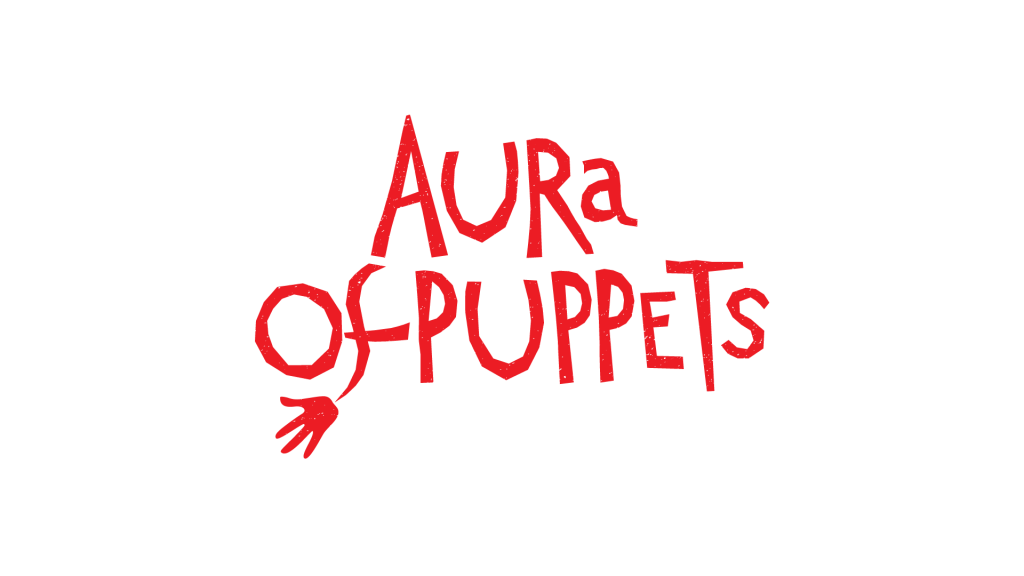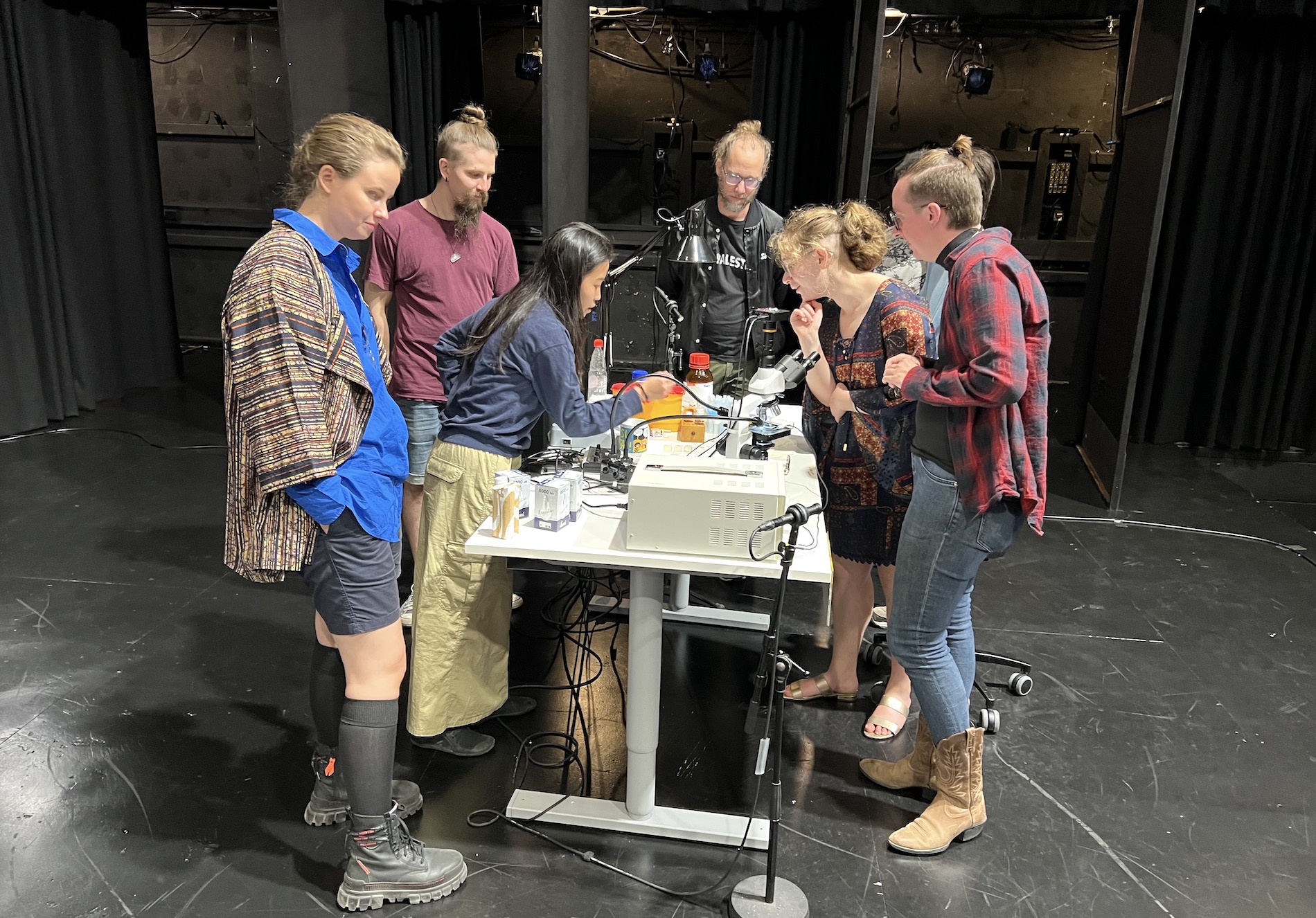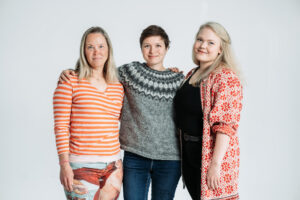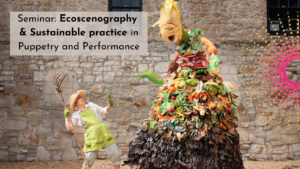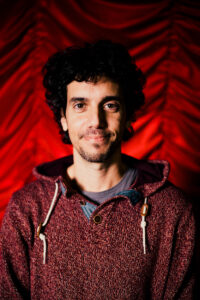It was a typical April day in Ithaca, New York: the calendar said “spring”, but the weather hadn’t quite caught on yet, with a chill lingering in the air and a “wintry mix” on the horizon. Undergraduate students were holed up in libraries to prepare for exams, and graduate researchers burrowed in their basement labs, huddled over their next round of experiments.
Professor Itai Cohen’s research group, however, was about to have a very different week. We woke to a decidedly atypical email in our inbox: “HAVE DEMOS READY. THE PUPPETEERS ARE COMING”. At the time, we had no idea who these “puppeteers” were or why they would be interested in our work. We had no idea what this would become – a collaboration that would one day see us voyaging across the Atlantic, visiting Helsinki for the first time, and watching the Nano Steps performance at Studio Pasila.
Our names are Kemper and Anna, and we’re both PhD students working for Professor Itai Cohen at Cornell University. Kemper is in their sixth year, and has spent their time studying the neuromuscular architecture used for fast flight control in fruit flies. When they’re not gluing teeny tiny magnetic pins to flies, they officiate for Ithaca’s local roller derby league under the name “Gluteus Cactimus”, and engage in their own creative projects, mostly in fiber arts. Their home is overflowing with sewing supplies, yarn, and even a spinning wheel. Anna is a second year student and studies colloidal suspensions (such as the common “oobleck” science demo). Outside of lab, she enjoys playing board games, caring for her houseplants, and dancing Lindy Hop at local swing dance events. She wants to visit as many waterfalls in upstate New York as she can before graduating.
Company Trial & Theatre’s visit to Cornell University
Aati Hanikka, Valtteri Alanen, and Iiris Syrjä came to visit us in April of 2022. We were fortunate enough to spend a week with them, introducing them to the many experiments conducted in our lab. Most of us have given lab tours before, to curious family members, young schoolchildren, or representatives from funding agencies. In some ways, sharing our work with artists wasn’t so different; everyone loves when demonstrations are hands-on, or when they can see a video of something unexpected.
However, the puppeteers were clearly more invested than the average lab tour. These visitors were not content to simply see something cool, smile politely, and move on – for everything we shared, we could immediately see them absorbing the information, filtering for the useful bits, and calculating how the science could be transformed into art. In the coming months, we exchanged follow-up emails: sending diagrams of experimental setups, copies of relevant studies, and links for specific products to buy. It was exciting to see our own work from a new perspective; to love an experiment not because of its utility, but because of its beauty.
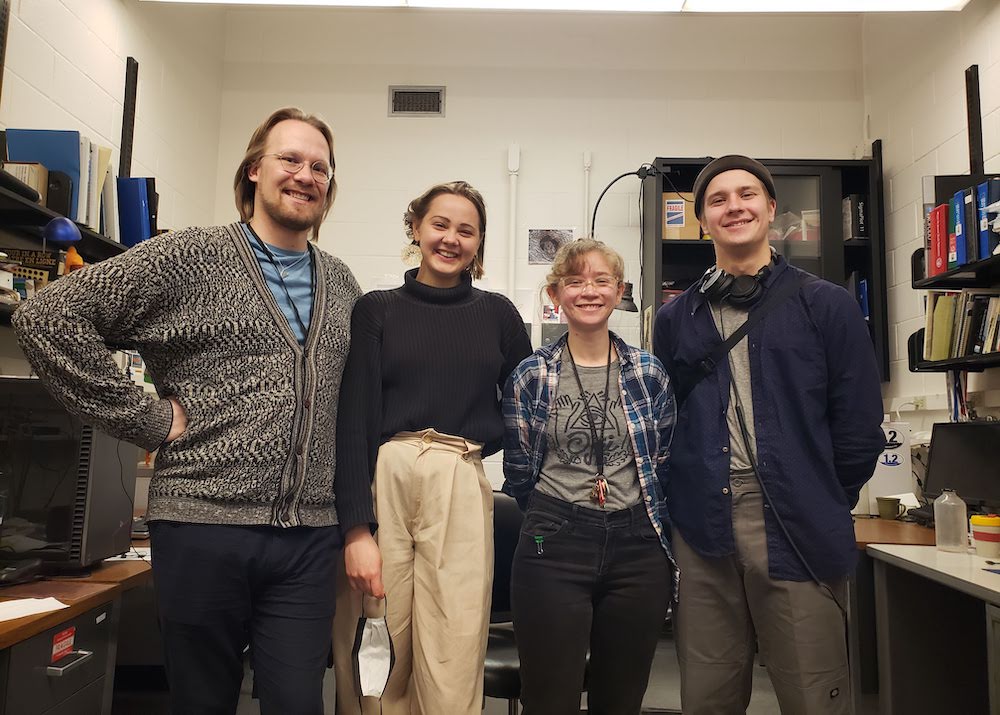
Manipulations in the lab and on stage
Ours was a two-way exchange. After spending time in the lab, the visiting puppeteers took us “backstage” for a puppeteering workshop of our own. We started from the very basics: what is a puppet? How does it move? From there, we moved on to the ultimate question: How do you take an inanimate object and transform it into a character an audience can connect with? Over the course of the evening, we took a collection of objects brought from our homes and offices, explored the different ways we could manipulate them as puppets, and wrote short puppet shows about some of the most universal human experiences: love, friendship, and academic peer review. It is always a pleasure to learn from an expert in their craft, and we walked away from the experience with a much greater appreciation for an art form many of us had not engaged with since our childhoods.
Despite the apparent differences between the disciplines, we found many similarities in our experiences as physicists and what we learned about puppetry. When a puppeteer begins to work with a new puppet, we learned they start by finding ways they can manipulate it so that they can get the largest amount of motion with the least input from its handler. Many physics experiments start from the same question: how can we get the biggest change in a system with the smallest change in its initial conditions? In science, the answer tells us something about what factors are most important for the underlying mechanics governing a particular experiment. In art, the answer leads you to the “character” of the puppet: which motions are most natural, what emotions they convey, and how that might be included in a story.
And, although some scientists would be reluctant to admit it, both disciplines rely heavily on an element of play, on trying new things just because you hope there will be an interesting result. The scientific method’s foundation is trial and error, and it demands perseverance through many failures to find the experiment that works.The artistic process, we found, is much the same.
Scientists and puppeteers also both develop intimate relationships with their systems. There’s an intuition there, where sometimes we know what’s going to happen without being able to explain how we know, which we saw reflected in how our new artist friends spoke about their work.
Scientists in Helsinki
Over a year after the puppeteers’ visit to our lab, we had the opportunity to visit Helsinki and see the closing performance of Nano Steps during its premiere run at Studio Pasila. The show opened on two lab tables, decked out with microscopes, bottles of chemicals, micropipettes, piezoelectric crystals, audio mixers, an electronic voltage amplifier, and a variety of other curious equipment. Two performers (Valtteri Alanen and En Ping Yu) came onstage to don white lab coats and work at the two stations. A large screen center stage showed in real time what they observed under the two microscopes. Under each microscope slide, there were particles – under one microscope, rugged, brown, lumpy particles of gravel; under the other, smooth, clear, spherical particles of plastic.
As scientists, we’re inclined to start telling you every detail – the specific origin of the gravel, the size distributions of the particles, the polymer that comprised the plastic, the percent monodispersity of the spheres and the chemical composition of the solvent in which they sat – but in this show, these experimental details weren’t so important. Remarkably, we didn’t find that dismissive of the details that are so important to our work, nor did it feel like the show “dumbed down” the science. Instead, it freed us up to focus on the feeling of doing science.
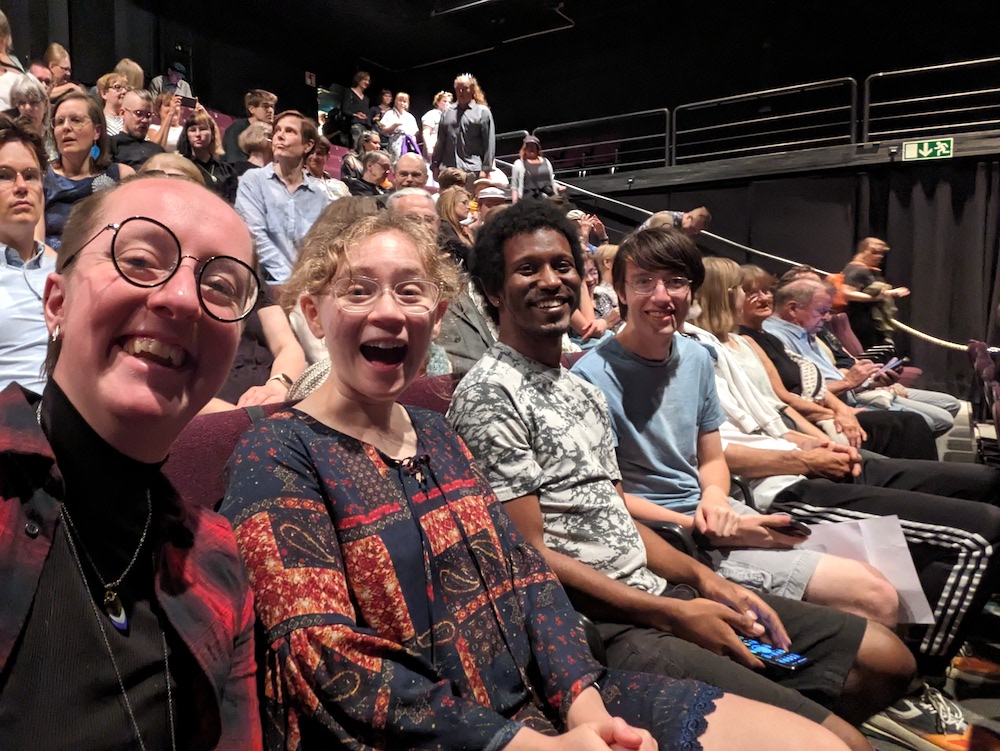
Under the performers’ careful hands, these microscopic particles came to life. By turning the right dial to just the right voltage setting, by whispering into a microphone at just the right frequency, we saw both types of particles startle awake and begin to move: shyly rolling out of view, brazenly spinning circles for the camera, or chasing each other around like children at the playground. The show was devoid of spoken dialogue – the only conversation that mattered was the conversation between scientist and system.
In the final scene of the show, one of the performers (En Ping Yu) entered the lab, coaxed her particles to life, and moved center stage to sit in reverence of her system of study. She wasn’t laboriously entering data points into a spreadsheet so she could analyze her results in MATLAB later. She wasn’t splitting her attention with a very urgent problem set due at 11:59pm that night. She wasn’t late for a meeting, she wasn’t concerned about grant money, she wasn’t absently wondering when she could slip away for a lunch break. No, this is science removed from the grind of life in academia – this is science as a quiet, personal, and almost spiritual experience. Science as a relationship with an arcane being, science as a séance with microscopic ghosts, science as communion with the nanoscale divine. Experiencing this alongside her, it reminded us of why we do what we do.
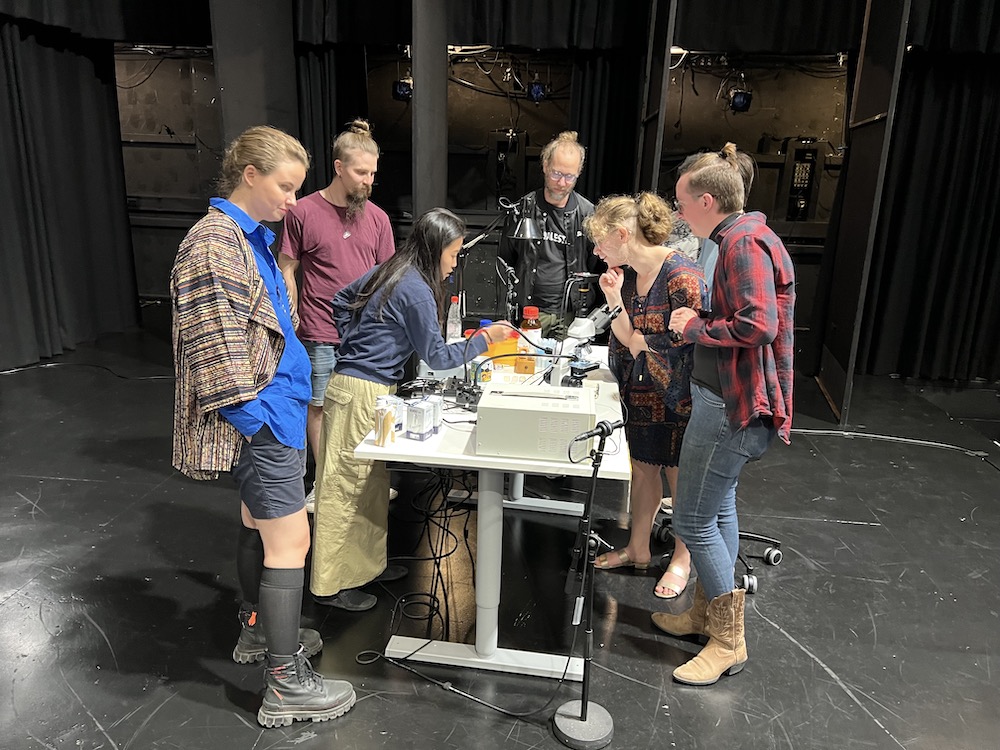
Artists and scientists alike are often asked to explain why our (esoteric, abstract, hyper-specific) work is worth doing. Scientists are trained to justify ourselves by explaining how our work could one day be used to invent new medical technology, or faster smartphones, or better weapons, and so on. But for many of us, those potential engineering applications are not the real motivators. It’s much harder to explain that sometimes, we just want to do something because… well, it’s cool. Because it stirs our souls. It was refreshing to see this feeling reflected back at us from the stage. Art is the best way to show other people what the inside of your soul looks like, and this show felt like the inside of a scientist’s soul. We are so grateful to have been able to participate in this collaboration and see its culmination at the Nano Steps show; we will carry what we have learned as we continue our scientific careers, and we sincerely hope to have many more collaborations with artists in the future.

Left: Aati Hanikka, Iiris Syrjä, Anna Barth, Valtteri Alanen, Kemper Ludlow, Suvi Tuominen curator of Helsinki City Theatre Stage for Contemporary Performance
